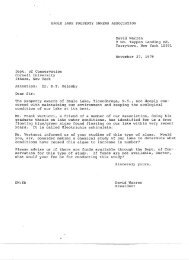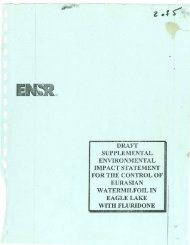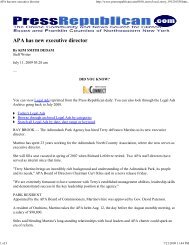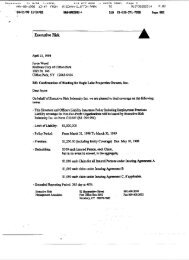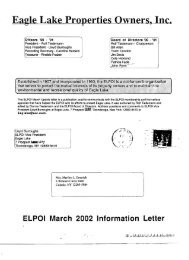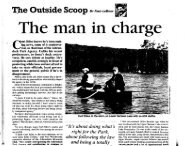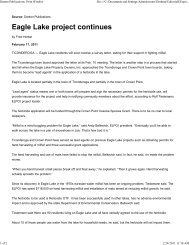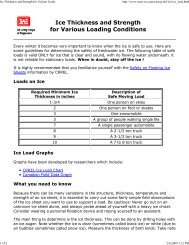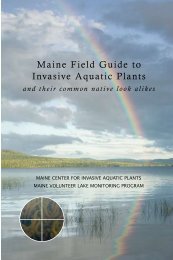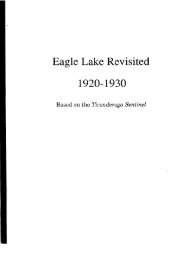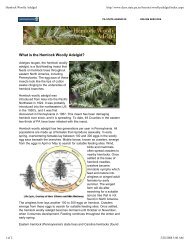Adirondack Park - Eagle Lake Property Owner's Inc.
Adirondack Park - Eagle Lake Property Owner's Inc.
Adirondack Park - Eagle Lake Property Owner's Inc.
Create successful ePaper yourself
Turn your PDF publications into a flip-book with our unique Google optimized e-Paper software.
The economic justification for ANS management is clear. The economic backbone of the<br />
<strong>Adirondack</strong> <strong>Park</strong> is supported by tourism, with visitors expending over $1.2 billion dollars<br />
annually and providing employment for over 26,000 people. According to Bill Osborne from<br />
Hamilton County, over 85 percent of visitors desire waterside lodging and about 70 percent want<br />
to swim, fish, or boat while visiting the <strong>Adirondack</strong>s. Water is a main ingredient of the tourism<br />
package that attracts visitors to the <strong>Adirondack</strong>s, and thus clean water is a main ingredient of<br />
jobs. Water also affects the quality of life of <strong>Adirondack</strong> residents in several important ways,<br />
including property values, drinking water quality, and ecosystem health. The proliferation of<br />
invasive species may be the greatest regional threat to water quality, with the negative effects<br />
already having been demonstrated through reductions in shoreline property values (and taxes)<br />
along heavily infested waters.<br />
Impacts of ANS in the <strong>Adirondack</strong> <strong>Park</strong> will continue to increase if current populations of ANS<br />
are left unchecked and new species of ANS enter the <strong>Park</strong>. If action is taken quickly, it may be<br />
possible to limit the spread of ANS and protect the ecologic and socioeconomic vitality of the<br />
<strong>Adirondack</strong>s. The <strong>Adirondack</strong> <strong>Park</strong> Aquatic Nuisance Species Management Plan provides<br />
guidance on management actions to prevent, control, and limit the impacts of ANS that have<br />
invaded or may invade the <strong>Adirondack</strong> <strong>Park</strong>.<br />
Plan Development<br />
The Plan represents a grass roots effort that has been very much in the public domain with<br />
multiple opportunities for individuals and groups to provide input. The document was written by<br />
a team of three persons: Dan Kelting (<strong>Adirondack</strong> Watershed Institute), Mark Malchoff (<strong>Lake</strong><br />
Champlain Sea Grant/ SUNY Plattsburgh), and Hilary Oles (<strong>Adirondack</strong> <strong>Park</strong> Invasive Plant<br />
Program) with additional guidance from the New York State Department of Environmental<br />
Conservation (NYSDEC), <strong>Adirondack</strong> <strong>Park</strong> Agency (APA), <strong>Lake</strong> Champlain Basin Program<br />
(LCBP), <strong>Adirondack</strong> Association of Towns and Villages (AATV), Cornell Cooperative<br />
Extension, the <strong>Adirondack</strong> Council, the Residents’ Committee to Protect the <strong>Adirondack</strong>s<br />
(RCPA), the Upper Saranac <strong>Lake</strong> Foundation (USLF), and the <strong>Lake</strong> George Association (LGA).<br />
After initial revisions following the guidance provided by the above organizations, the Plan was<br />
circulated to a Review Committee consisting of lake and river associations, state and local<br />
government, and the research community. The Plan was revised again following the<br />
recommendations of the Review Committee and then made available to the participants in the 3 rd<br />
Annual <strong>Adirondack</strong> Water Quality Conference, who provided input on the Plan at the conference<br />
on August 16 th , 2005.<br />
An <strong>Adirondack</strong> <strong>Park</strong> ANS Management Plan Steering Committee was formed immediately<br />
following the conference, with the main charge of completing the Plan document. Members of<br />
the Steering Committee are listed in Appendix B. This version of the Plan reflects the comments<br />
provided at the conference (see Appendix A) with additional due attention paid to the guidance<br />
provided by the New York State Invasive Species Task Force Report, which was released for<br />
public comment in August 2005. The Plan was posted for public comment via the World Wide<br />
Web at http://www.paulsmiths.edu/PAGE=1685/page.pl through December 2005. Public<br />
comments sent to committee members through December were incorporated into a fourth draft<br />
of the Plan.<br />
4




